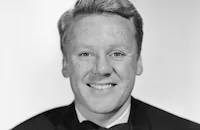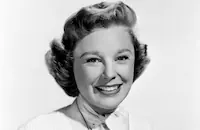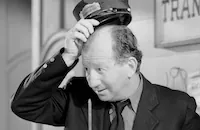The Bride Goes Wild

Brief Synopsis
Cast & Crew
Norman Taurog
Van Johnson
June Allyson
Butch Jenkins
Hume Cronyn
Una Merkel
Film Details
Technical Specs

Synopsis
Martha Terryton, a prudish grade school teacher living in Vermont with her two maiden aunts, takes a job as an illustrator of children's books at the McGrath House publishing company in New York City. Soon after arriving in New York, Martha learns that McGrath House's "foremost children's book author," Greg Rawlings, known to his young readers as "Uncle Bumps," has threatened to leave for Canada before completing his latest book. Though caught up in the romantic pursuit of Tillie Smith, Greg an alcoholic playboy, quickly turns his attentions to Martha when he first meets her in the publishing house lobby. Martha, unaware that she is speaking with "Uncle Bumps," agrees to join him on a coffee break. At the café, Greg secretly "spikes" the coffee with alcohol, and the two get drunk. When a café patron reveals Greg's identity, Martha leaves in tears and threatens to expose "Uncle Bumps" as a fraud. Still drunk, Martha tells publisher John McGrath that she is too tipsy to meet her prim cousin Helen Oldfield for dinner. Helen, the secretary of the Juvenile Betterment Society, has the power to ban all of Greg's books, and consequently, McGrath tries to keep his relationship with Martha in good standing. Mcgrath tries to calm Martha by telling her that Greg is a widower who drinks to cope with his grief and his worries about his son. Helen believes McGrath's lie, but to keep the story alive, McGrath searches for a juvenile delinquent boy to pose as Greg's son. While visiting the Brindley Home for Boys, McGrath finds a young boy named Danny to play the part in his hoax. After meeting the ill-mannered Danny, Martha recommends that he spend a day in the country, and insists on joining Greg and Danny on a trip to the Junior Woodsman camp. The unexpected trip to the country forces Greg to cancel his plans to meet Tillie, who has come to New York in the hopes of rekindling her romance with him. Greg's hoax soon goes awry when Danny decides that he wants to reform and be adopted by Greg. In time, Greg falls in love with Martha, and the two plan to get married. Martha, however, breaks off the engagement when she discovers the truth about Danny. Still wanting to adopt Danny, Martha realizes that the only way to do so is to marry Bruce Kope Johnson, her hapless hometown sweetheart. Martha's wedding to Bruce seems inevitable until Danny succeeds in delaying the ceremony long enough for Greg to arrive and elope with her. Martha willingly returns to Greg's arms, and the two look forward to adopting Danny.

Director

Norman Taurog
Cast

Van Johnson

June Allyson

Butch Jenkins

Hume Cronyn

Una Merkel

Arlene Dahl
Richard Derr
Lloyd Corrigan

Elisabeth Risdon
Clara Blandick
Kathleen Howard

Cecil Cunningham

Clinton Sundberg
Almira Sessions
Napoleon Whiting
Alvin Hammer
Ferris Taylor
Estelle Etterre
Jean Dean
Ethel Tobin
William Forrest
Jack Rice

Frank Ferguson
Robert Emmett Keane

Byron Foulger
Glen Arthur Berry
Eilene Janssen
Billy Jamison
Florence Stevens
Paul Power
Robert E. O'connor
Celia Travers
Henry Hall
Garry Owen
Dewey Robinson
Rebel Randall
Jackie Searle
Tom Dugan
Stanley Blystone
John Albright
Phillip Bernard
Erville Alderson
Jack Lipson
Tony Taylor

Billy Gray

Connie Gilchrist
Leo Wilson
Robert Scott
George Mcdonald
José Alvarado
David Bair
Teddy Infuhr
George Nokes
Billy Severn
Edward Earle
Joe Whitehead
Rocco Lanzo
Robert Spencer
Sam Ash
Roger Cole
Frank Peterson

Hank Mann
Clarence Hennecke
Phil Dunham
George Boyee
Lou Bridge

Bess Flowers
Rhea Mitchell
Kay Deslys
Mickey Martin
Catherine Courtney
Crew
Albert Beich
George Boemler
Jack Dawn
Dale Deverman
Otto Dyar
Jack Gertsman
Cedric Gibbons
Sydney Guilaroff
Eylla Jacobus
Ray June
Rudolph G. Kopp
Arthur Krams
Harry Mcafee
Mervyn Price
Helen Rose
Douglas Shearer
Sid Sidman
Sidney Wagner
Edwin B. Willis
William H. Wright

Photo Collections
Videos
Movie Clip


Trailer
Film Details
Technical Specs

Articles
The Bride Goes Wild
So popular was the Allyson-Johnson pairing that joint fan clubs were formed. MGM studio head L.B. Mayer encouraged them to date. Fans even believed the pair was married in real life. In truth, Allyson and Johnson had been friends since the early days of their careers, when they were both living in New York. They did appear together in public once in Hollywood but it was purely for P.R. purposes. Their friendship made working together a pleasure, though occasionally their camaraderie did create problems on set. One story that emerged from the filming of The Bride Goes Wild had Johnson and Allyson cracking each other up to the point that director Norman Taurog called off shooting for the day. When they resumed the next day, Taurog wouldn't allow Allyson and Johnson to speak off camera, and he filmed each of their close-ups without the other on set.
Even after they married other people (Allyson wed Dick Powell and Johnson married Evie Wynn, the former wife of his friend Keenan Wynn), the rumors persisted that the two stars were hitched. In her biography A Most Improbable Star Allyson tells the story of one Halloween when the two couples and their children were celebrating together. Johnson and Allyson opened the door to hand out candy and one teenage trick-or-treater gasped, "See, I told you they were married in real life, too." Fans even wrote in to suggest baby names for Johnson and Allyson going with the traditional Van Jr. for a son and the creative Vanjee (a combination of their names) for a girl.
Allyson and Johnson's on screen chemistry is delightfully evident in The Bride Goes Wild. Johnson plays a hard-drinking children's author who just happens to hate kids. He hides behind the kindly pseudonym Uncle Bumps. But once Allyson, a New England teacher who wins a contest to illustrate one of Uncle Bumps' books, meets Johnson, his cover is blown. With Allyson threatening to expose his true persona, Johnson and his publisher (Hume Cronyn) cook up a scheme involving a dead wife and a troubled son (Jackie 'Butch' Jenkins) to pacify her. Of course, along the way, Allyson and Johnson inevitably fall in love. As MGM put it, in promotions for the film, "When a Miss from the Country who's Prissy but Kissable Meets a Guy from the City Who's Fresh but Likable. Watch The Screen Go Romantically Combustible."
In addition to Allyson and Johnson, the supporting cast of The Bride Goes Wild is especially noteworthy. Hume Cronyn ended his five year run at MGM in the film. He first appeared for the studio in The Cross of Lorraine in 1943. Cronyn's other MGM outings included The Postman Always Rings Twice (1946) and Ziegfeld Follies (1946). Una Merkel appears in The Bride Goes Wild as Cronyn's secretary, Arlene Dahl plays Johnson's ex-girlfriend and Clara Blandick is featured as Allyson's aunt (Blandick is best known for playing Auntie Em in The Wizard of Oz [1939]).
Even the child actors are famous in The Bride Goes Wild. Most prominent is Jackie 'Butch' Jenkins, who was nearing the end of his career as a freckle-face child star. He made just one more film, Big City (1948). Another youngster you might recognize is Billy Gray as one of the orphans. Gray went on to play young Bud Anderson in the television series Father Knows Best.
Producer: William H. Wright
Director: Norman Taurog
Screenplay: Albert Beich
Cinematography: Ray June
Film Editing: George Boemler
Art Direction: Cedric Gibbons, Harry McAfee
Music: Rudolph G. Kopp
Cast: Van Johnson (Greg Rawlings), June Allyson (Martha Terryton), Jackie 'Butch' Jenkins (Danny), Hume Cronyn (John McGrath), Una Merkel (Miss Doberly), Arlene Dahl (Tillie Smith Oliver).
BW-98m. Closed captioning.
by Stephanie Thames

The Bride Goes Wild
TCM Remembers Van Johnson - Important Schedule Change on TCM In Honor To Salute VAN JOHNSON
The new schedule for the evening of Tuesday, December 23rd will be:
8:00 PM In the Good Old Summertime
9:45 PM A Guy Named Joe
12:30 AM Thirty Seconds Over Tokyo
2:30 AM The Last Time I Saw Paris
4:30 AM Thrill of a Romance
Van Johnson (1916-2008)
Van Johnson, the boyish leading man whose clean cut, All-American appeal made him a top box-office draw for MGM during World War II, died on December 12 in Nyack, New York of natural causes. He was 92.
He was born Charles Van Dell Johnson on August 25, 1916, in Newport, Rhode Island. By his own account, his early childhood wasn't a stable one. His mother abandoned him when he was just three and his Swedish-born father offered little consolation or nurturing while he was growing up. Not surprisingly, Johnson found solace in singing and dancing lessons, and throughout his adolescence, he longed for a life in show business. After graduating high school in 1934, he relocated to New York City and was soon performing as a chorus boy on Broadway in shows such as New Faces of 1936 and eventually as an understudy in Rodgers and Hart's musical, Too Many Girls in 1939.
Johnson eventually made his way to Hollywood and landed an unbilled debut in the film version of Too Many Girls (1940). By 1941, he signed a brief contract with Warner Bros., but it only earned him a lead in a "B" programmer Murder in the Big House (1941); his contract soon expired and he was dropped by the studio. Johnson was on his way back to New York, but as luck would have it - in the truest Hollywood sense - friends Lucille Ball and Desi Arnaz introduced him to Billy Grady, a lead talent scout at MGM, which was currently Ball's new studio. Johnson was signed up and almost immediately MGM had a star on its hands.
It might have been slow going at first, with Johnson playing able support in films such as Dr. Gillespie's New Assistant and The War Against Mrs. Hadley (both 1942). By 1943 the studio capitalized on his broad smile and freckles and starred him in two of the studio's biggest hits: A Guy Named Joe and The Human Comedy. Those two films transformed him into a boxoffice draw with a huge following, particularly among teenage girls. A near fatal car accident that same year only accentuated the loyalty of his fans, and his 4-F status as the result of that accident created an opportunity for him when so many other leading actors of the era (James Stewart, Clark Gable) were off to war. Johnson was quickly promoted as MGM'sleading man in war heroics and sweet romancers on the big screen: The White Cliffs of Dover, Thirty Seconds Over Tokyo (both 1944), Thrill of a Romance, the episodic Week-End at the Waldorf (both 1945), and a musical remake of Libeled Lady entitled Easy to Wed (1946).
Hits though these were, it wasn't until after the war that Johnson began to receive more dramatic parts and better material such as supporting Katharine Hepburn and Spencer Tracy in the political farce State of the Union (1948). other significant roles included the well-modulated noir thriller The Scene of the Crime, the grim war spectacle Battleground (both 1949), the moving domestic drama Invitation (1952) in which he played a man who is paid to marry a woman (Dorothy McGuire) by her father. Before he left MGM, he closed his career out in fine form with the sweeping musical Brigadoon, co-starring Gene Kelly and Cyd Charisse; and the lilting soaper The Last Time I Saw Paris (both 1954) with Elizabeth Taylor.
After he left MGM, the parts that came Johnson's way weren't as varied, but he had his moments in The Caine Mutiny (1954), the beguiling romance drama Miracle in the Rain (1956) with Jane Wyman; and his lead performance in one of the first successful made for-TV-movies The Pied Piper of Hamelin (1957). By the '60s, Johnson returned to the stage, and played the title role in London's West End production of The Music Man. He then returned to Broadway in the drama Come on Strong. He still had a few good supporting parts, most notably as Debbie Reynolds' suitor in Norman Lear's scathing satire on marital differences Divorce American Style (1967); and television welcomed his presence on many popular shows in the '70s and '80s such as Maude, Fantasy Island, The Love Boat and of course Murder She Wrote. There was one last graceful cameo in Woody Allen's The Purple Rose of Cairo (1985), yet for the most remainder of his career, Johnson worked mainly on the dinner theater circuit before retiring from showbiz completely by the mid-90s. He is survived by a daughter, Schuyler.
by Michael T. Toole
TCM Remembers Van Johnson - Important Schedule Change on TCM In Honor To Salute VAN JOHNSON
Quotes
Trivia
Notes
The working title for this film was Virtuous. During production, cinematographer Ray June replaced Sidney Wagner, who died of a stroke on July 7, 1947. According to a pre-production Hollywood Reporter news item, some location shooting was set to take place in Newbury Park, CA. Van Johnson and June Allyson recreated their roles for a Lux Radio Theatre broadcast on June 26, 1950.















